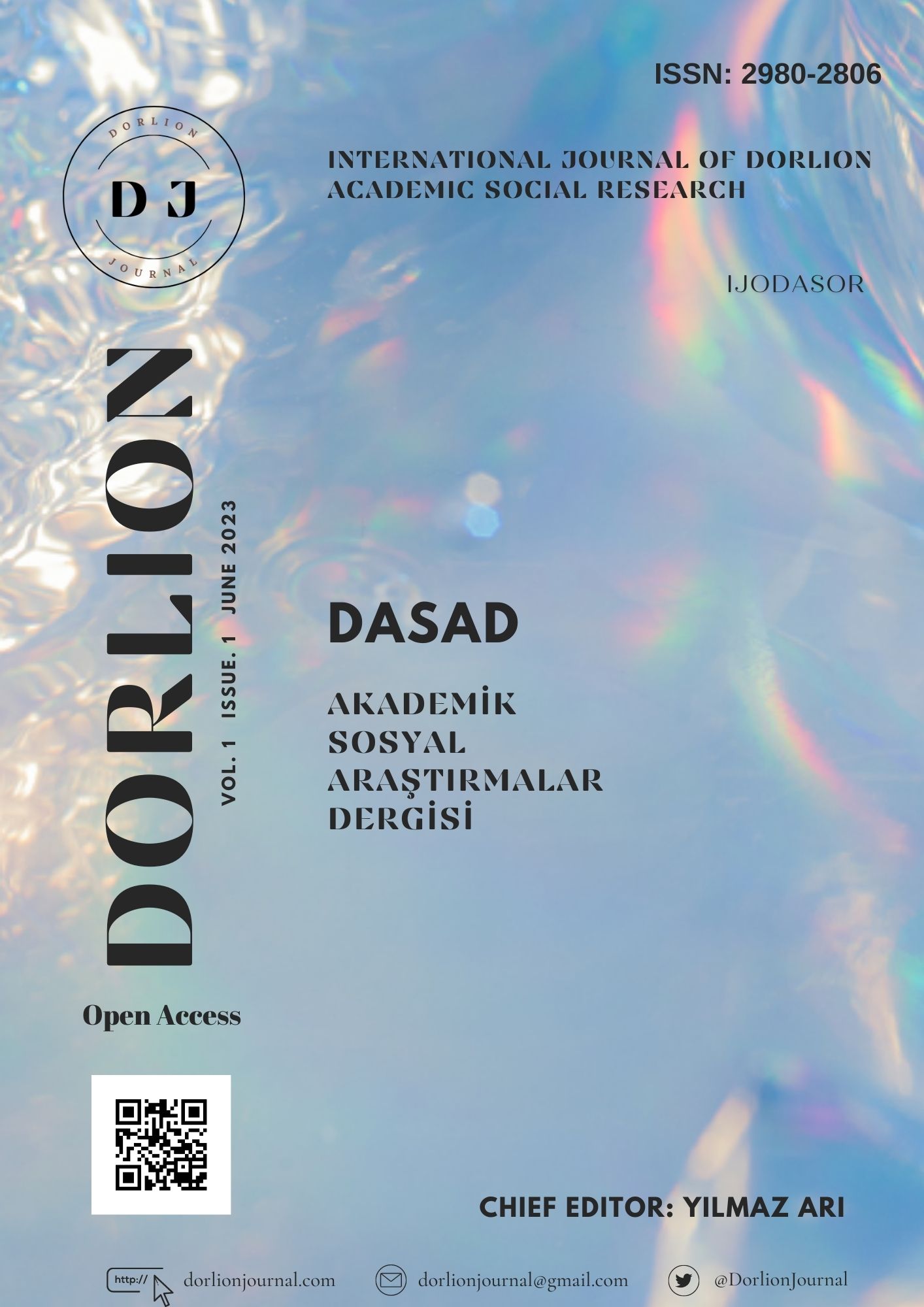Depiction of Aras in the Classical Sources of Islamic History
DOI:
https://doi.org/10.5281/zenodo.8051470Keywords:
History of Islam, Aras River, Mount Ararat, Ashab-ı Rass, AzerbaijanAbstract
Aras River was significantly mentioned in the Islamic sources. Impression of Muslim conquerors was reflected in the historical sources, during the Islamic conquests, in the process of joining the settlements clustered around the river to the borders of the Islamic state. Especially the Great Ararat mountains have attracted their attention. In this context, the sources emphasized the political, cultural and economic conditions of the region, as well as some mythological narratives about the Aras river and the Ararat mountain. For example, Ibn Havkal, who counted the cities in the region one by one and talked about the conditions of that period in detail, says: “Farming is more common here, and the trade of animals and animal products is popular. Delicious fish are found in the Aras River, and therefore they are transported and sold as far as Iraq. Companions of the Rass, destroyed by God Almighty, lived here. As a matter of fact, when the cities on both sides of the river are examined carefully, it is understood that these were once turned upside down.” Yakut el-Hamavi who was talking about the legends about the mountains of Ararat, also mentioned the agricultural richness of the Aras River basin. He noted that wonderful pomegranates grew unlike any other around the river and his figs were astonishing. He explained that the grapes were dried in tandoor because the sun was not seen much due to the abundance of flies in the region. Ebü'l-Fidâ mentioned that the Aras (er-Rass) River flows from the Erzurum (Kalikala) mountains towards Debîl. He stated that there were three hundred and sixty ruined cities and villages around the river and pointed out that the Ashabu'r-Rass, mentioned in the Quran, lived there. In this study, works on history, geography, bulletin and the pier written by Islamic historians and Muslim travelers such as Ibn al-Faqih (d. 289/902), Ibn Hurdazbih (d.300/912), Kudâme b Cafer (d.337/948), Istahri (d.340/952), Ibn Havkal (d. 367/977), Makdisi (d. 390/1000), Herevî (d. 611/1215), Ibn Jubayr (d. 614/1217), Qazvinî (d. 682/1283), Abu'l-Fidâ (d. 732/1331), Ibn Fadlallah al-Umarî (d. 749/1349) and Ibn Battuta (d. 770/1368) will be taken as basis. First of all, the impressions of the relevant sources about the Aras River and its surroundings, then the stories about the Ashabu'r-Rass and some other mythological narratives will be examined.
References
KAYNAKÇA / REFERENCES
Ebü'l-Fidâ, İmadüddin İsmâil b. Ali. Takvîmü’l-Büldân. nşr. M. Reinaud - Mac Guckin de Slane. Paris: A L'imprimerie Royale, 1860.
Ertaş, Kasım. "1915’ten Önce Bitlis Vilayetinde Ermeniler ve Vilayetin İdari Hayatındaki Konumları". Şırnak Üniversitesi İlahiyat Fakültesi Dergisi 8 / 16 (Nisan 2017), 77-99.
Güneş, Hüseyin. İslam Tarihi Kaynaklarına Göre Nuh Tufanı ve Cudi Dağı. Şırnak: Şırnak Belediyesi, 2020.
Harman, Ömer Faruk. "Ashâbü’r-Res". Türkiye Diyanet Vakfı İslâm Ansiklopedisi. Erişim 08 Mart 2021. https://islamansiklopedisi.org.tr/ashabur-res.
Hudûdü’l-Âlem mine’l-Meşrik ile’l-Mağrib, (Müellifi Meçhul). thk. Yusuf el-Hâdî. Kahire: ed-Dârü’s-Sekâfiye, 1999.
İbn Havkal, Ebü’l-Kâsım en-Nasibî. Kitâbü Sûrati’l-Arz. Beyrut: Dâru Mektebeti’l-Hayat, 1992.
İbn Hurdazbih, Ebü’l-Kâsım Ubeydullah b. Abdullah. el-Mesâlik ve’l-Memâlik, ed. M. J. De Goeje. Leiden: Matbaatü Brill, 1889.
İbnü’l-Fakîh, Ebû Bekir Ahmed b. Muhammed el-Hemedanî. Kitâbü’l-Büldân. thk. Yusuf Hâdî. Beyrut: Âlemü’l-Kütüb, 1996.
İbnü’l-Verdi, Ebu Hafs Ömer b. Muzaffer el-Bekrî. Haridetü’l-Acaib. thk. Enver Mahmud Zennati. Kahire: Mektebetü’s-Sekafeti’l-İslamiyye, 2008.
İdrisî, Ebû Abdullah Muhammed b. Muhammed el-Hammûdî. Nüzhetü’l-Müştâk fî İhtirâki’l-Âfâk. Kahire: Mektebetü’s-Sekâfeti’d-Dîniyye, 2002.
İstahrî, Ebû İshâk İbrahim b. Muhammed. Mesâlikü’l-Memâlik. ed. M. J. De Goeje. Leiden: Matbaatü Brill, 1927.
Karan, Cuma. Diyâr-ı Bekr’in Sosyo-Ekonomik Tarihi (VII-X), İstanbul: Kitap Dünyası Yayınları, 2022.
Kazvinî, Ebû Yahya Zekeriya b. Muhammed. Âsârü’l-Bilâd ve Ahbârü’l-İbâd. Beyrut: Dâru Sâdır, t.y.
Kırca, Celal. "Mecmau’l-Bahreyn". Türkiye Diyanet Vakfı İslâm Ansiklopedisi. Erişim 08 Mart 2021. https://islamansiklopedisi.org.tr/mecmaul-bahreyn--musa-hizir.
Kurtubî, Ebu Abdullah Muhammed b. Ahmed. el-Cami’u Li Ahkâmi’l-Kur’ân. Kahire: Dârü’l-Kütübi’l-Mısriyye, 1964.
Makdisî, Ebû Abdullah Muhammed b. Ahmed. Ahsenü’t-Tekâsim fi Ma’rifeti’l-Ekâlim. Leiden: Matbaatü Brill, 1909.
Razî, Ebu Abdullah Muhammed b. Ömer. Mefatihü’l-Gayb. Beyrut: Dâru İhya, 1420.
Tuncel, Metin. "Aras". Türkiye Diyanet Vakfı İslâm Ansiklopedisi. Erişim 08 Mart 2021. https://islamansiklopedisi.org.tr/aras.
Öz, Mustafa. "Gâliyye". Türkiye Diyanet Vakfı İslâm Ansiklopedisi. Erişim 20 Mart 2021. https://islamansiklopedisi.org.tr/galiyye.
Yakubî, Ahmed b. İshak. el-Büldan. Beyrut: Darü’l-Kütübi’l-İlmiyye, 1422.
Yakut, Ebû Abdullah Yâkût b. Abdullah el-Hamevî. Mu’cemü’l-Büldân. Beyrut: Dâru Sâdır, 1977.

Downloads
Published
How to Cite
Issue
Section
License
Copyright (c) 2023 Hüseyin Güneş

This work is licensed under a Creative Commons Attribution-NonCommercial 4.0 International License.




